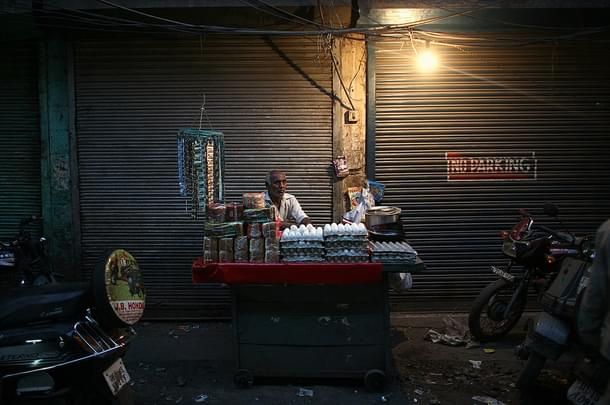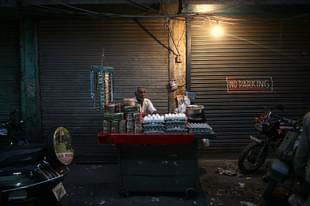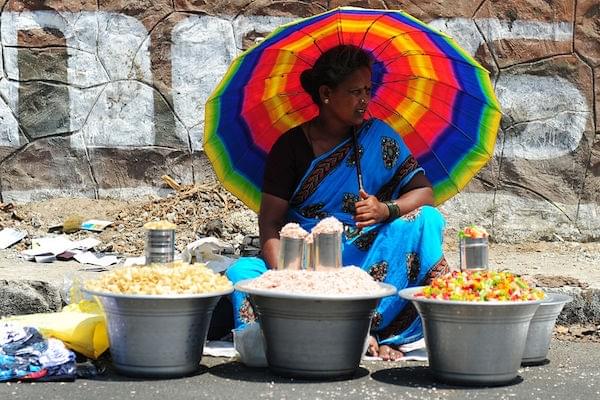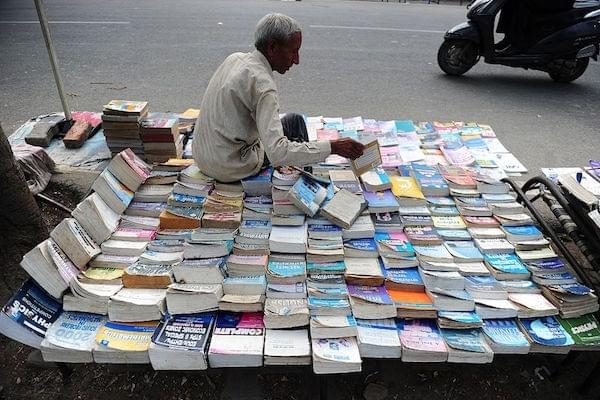Magazine
No Bottom-Up Reforms
Madhu Purnima Kishwar
Jul 22, 2016, 05:31 PM | Updated 05:31 PM IST
Save & read from anywhere!
Bookmark stories for easy access on any device or the Swarajya app.


It is commonly accepted that the two most reliable tests for the success or failure of economic reforms are:
One, whether rules for entry into the world of enterprise and survival thereafter is controlled by the State machinery in an arbitrary manner, or whether there is a transparent regime which allows a level playing rule-based regime for the same.
Two, whether bribe rates for placating concerned officials or government employees and related mafia networks have gone up or down.
While the concerns of the corporate sector with regard to “ease of doing business” are under constant discussion, by contrast, the challenges faced by micro and nano enterprises in the unorganised sector are far lower in the economic and political priorities of our rulers. In other words, the agenda of economic reforms remains top-down, instead of bottom-up. This neglect is particularly tragic considering that no more than 4-5 percent of India’s labour force is employed in the corporate sector. Over 90 percent find employment in the unorganised or self-organised sectors of our economy.
This neglect is partly due to a common misconception that the unorganised sector works outside government controls. Unfortunately, the widespread poverty in the self-organised sector is largely due to the fact that people working in this sector are among the worst victims of Statist controls and the still flourishing License-Quota-Raid Raj.
This essay uses the plight of street vendors and hawkers as an illustrative example of the pitifully slow progress of the agenda of economic reforms in India with regard to the livelihood concerns of the tens of millions who work in the unorganised sectors. The continuing assaults on these nano entrepreneurs, despite a long history of battles to secure legal status, shows the entrenched power of vested interests.
A more rational and liberal regime for this sector was a low hanging fruit for the Modi government to pluck since basic groundwork on this issue has already been done, and Prime Minister Atal Bihari Vajpayee had already set the broad framework for this policy during NDA 1. But thus far, we have seen zero progress on this issue.
Street traders constitute 2.5 percent of the urban population and are also becoming important players in urbanising villages as they grow in population, or on account of being situated on highways. Thus, ever-growing millions find employment in and enter the world of enterprise as street traders. If trade is the lifeblood of any economy, street vendors and mobile hawkers are its most dynamic component because they carry goods of daily consumption either to the doorstep of consumers or at far more convenient locations than formal markets, that too at rates lower than in established commercial outlets. The vitality of this sector can be gauged from the fact that the humble street fruit and vegetable vendors of India have beaten hollow the much-hyped air-conditioned outlets set up by Reliance Fresh for selling fruits and vegetables. This is perhaps the first time that the Almighty Ambanis have faced defeat to the point of closure in any domain and that too by the collective might of lowly and despised street vendors who never had a level playing field. In fact, they work in an extremely hostile environment.
Traditionally, street traders came under the discipline of market committees, but under the British, it became illegal to engage in this occupation without procuring a fee-based license from the local municipality. The British introduced the system to earn revenues for the colonial regime, but in post-Independence India, it progressively became an instrument of extortion through the simple strategy of blocking access to tehbazari licenses. On the one hand, vending without tehbazari is treated as a serious enough offence to merit confiscation of goods and permanent removal from that site. On the other hand, the municipalities wilfully refuse to establish a transparent rule-based system for bestowing licenses.
This, in effect, means that the vast majority of vendors got haplessly trapped in a web of illegality even while pursuing a perfectly legal occupation. They exist at the mercy of police, municipal inspectors and political touts. As per Manushi’s calculations following interviews with hundreds of vendors across Delhi in 2001, street hawkers were being fleeced of at least Rs 500 crore per year on account of their “illegal” status. The amount is much higher today. This, despite the fact that way back in 1989, in NDMC vs. Sodan Singh, the Supreme Court of India had ruled that street vending is covered under the “right to livelihood” guaranteed under the Indian Constitution.
Yet, street vendors continued to face daily assaults on their rights, including police beatings and frequent clearance operations carried out mainly with a view to striking terror and raising the amount of daily, weekly or monthly hafta extracted from them.

I had documented the wretched plight of vendors in a documentary film titled, Udarikaran—Kewal Oopar ka Udaar? (License Permit Raj: A View From Below) telecast by Doordarshan in 1997.
Its telecast brought numerous vendors knocking at the doors of Manushi pleading with us to go beyond depicting their plight on film and do something to ameliorate it. After prolonged consultations with vendors across the city to deepen our understanding of the problem, Manushi organised a public hearing of street vendors in 2001 presided over by the then Chief Vigilance Commissioner, N Vittal, who was deeply moved by what he heard and saw. He wrote to the state government to reform the system. But most amazing of all was the response of then Prime Minister Vajpayee, who announced a historic new policy for street vendors solely on the basis of what he read about the issue in Manushi and a couple of news reports, along with the note circulated by Vittal. This historic policy document is an apt example of “bottom-up agenda of economic reforms”. It accepted the core demands of Manushi that the principle of supply and demand befitting a market economy be allowed to decide the number of street vendors in any city or town keeping its population size and consumer base in mind, instead of arbitrarily fixed restrictive quotas.
It also recommended the creation of three categories of clearly designated hawking zones in every city—green zone for open access, amber zone for fee-based access, and red zone for restricted access. To the best of my knowledge, in no other country in the world, policy reform for street vendors has come directly from the Prime Minister’s office, since this is considered a lowly municipal affair.
Unfortunately, the BJP leaders of the time in Delhi responded with great alarm and annoyance at the announcement of this new policy and worked hard to sabotage its implementation by enhancing the frequency and brutality of clearance operations so that the bribe rates began escalating dramatically. This is because MPs, MLAs and municipal councillors of every single party, especially the ruling party, are all integral part of the extortionist mafias. As long as vendors are vulnerable, they can also be used as captive banks by political parties. That is why BJP leaders responded with wrath and hostility towards Manushi for having won over PM Vajpayee’s support in favour of vendors. Consequently, clearance operations became more frequent and more violent in order to strike terror and jack up bribe rates.
Even though Vajpayee seemed helpless in curbing the vengeful actions of his party colleagues, many of whom were senior MPs and even cabinet ministers, he was astute enough to set up a National Task Force to draft a national policy for vendors. Manushi and several vendors’ unions were also part of this Task Force. Unfortunately, the Vajpayee government lost power soon after this policy was announced in January 2004.
Ironically, the UPA government picked up the issue with much fanfare and pretended to take it further by setting up a National Commission for Micro Enterprises, which also took on the task of redrafting the National Policy for Street Vendors announced by the Vajpayee government. However, the Congress Party also cleverly ignored the actual implementation of the policy and instead, tried to win brownie points with vendors’ unions by enacting a new law entitled Street Vendors Livelihood Protection and Regulation Act 2014. Thus it took 13 long years before the new policy for vendors announced by Prime Minister Vajpayee got translated in the form of an all-India legislation. However, within four months of the enactment of the new law, the UPA government was thrown out of power.
The implementation of the UPA-enacted law is bound to pose severe problems because of serious flaws entrenched in it. To begin with, it bestows the power to issue vending licenses and create hawking zones in the hands of the very same municipal councillors and officials who are the worst enemies of street vendors. By contrast, the Vajpayee-announced policy of 2001 had envisaged a more liberal regime and put curbs on the arbitrary powers of the babus and netas. At the behest of the Ministry of Urban Development and Poverty Alleviation, I had worked closely with Dr HS Anand, the then Secretary, Minister of Poverty Alleviation and Urban Development, to draft a model legislation that was more in tune with Vajpayee’s liberal intent.
Unfortunately, thanks to the intervention of the National Advisory Council, the law that was finally enacted by UPA in 2014 allowed many loopholes that maintain the arbitrary powers of municipal agencies, police as well as municipal corporators. In addition to drafting the national legislation, I had also prepared a model law for the Delhi state government, along with Delhi Chief Secretary Rakesh Mehta. This envisaged a far more radical but practical vending policy than contained in the national legislation. It freed the entire exercise from the clutches of municipal councillors by mandating the creation of an autonomous body called the Street Vendors Protection Authority which was given the mandate of planning hawking zones and establishing a transparent process for bestowing tehbazari on vendors.
This body was to have a representation of qualified urban planners for creating well designed hawking zones—a skill totally lacking in our municipal babus. It also had a well-defined exit policy to make space for new entrants to this occupation while easing out those who had had 10-15 years of protected tehbazari.
We expected the Modi government with its emphasis on employment generation to speedily correct the flaws in the UPA-enacted law and take on the job of creating well-ordered hawking zones along with a fair and transparent system for legalising the presence of vendors. Unfortunately, there has been no meaningful initiative on this front.
Some years ago, in a few cities such as Bhubaneswar and Rajkot, people-friendly IAS officers tried to create some hawking zones, but even in these cases, the effort was not citywide but confined to a few clusters involving 2,000-3,000 vendors, while the rest remained unprotected. As those IAS officers retired or moved on to other portfolios, the experiment lost momentum. The only progress reported thus far is that municipalities in several cities have appointed Town Vending Committees mandated by the Street Vendors Act. Some have also attempted to carry out surveys of street vendors. But there is no real progress in implementing the Act. Saddest of all, even in the capital city of Delhi, not a single hawking zone has been created till date, barring a small cluster in Nehru Place managed by Manushi under orders from the High Court.
It is noteworthy that the Delhi Municipal Corporation has been ruled by the BJP since 2012. Had the political leadership at the top given clear instructions to municipal councillors that legalising hawker markets in a well-ordered manner is a high-priority issue, Delhi could well have become a role model for the rest of India. Even in Nehru Place, the police and municipality have brought in nearly 300 unlicensed vendors who are paying Rs 500 per day per stall by way of bribes and yet have their goods confiscated every now and then. Even the High Court-protected vendors are not spared extortion and confiscation drives.
Granted that this issue comes under the domain of municipalities and therefore is a state subject. But so is sanitation, and yet NaMo has made Swachh Bharat Abhiyan his pet project. In fact, creation of clean and well-ordered hawking zones would have tied in very well with the Swachhta Abhiyan because orderly hawking zones presuppose proper civic infrastructure, including neat and uncluttered pavements, proper drainage and garbage disposal system.

Implementation of a rational hawking policy also tunes in well with the PM’s Smart Cities Project. In Bangkok, Kuala Lumpur and other East Asian countries, hawker markets are a great tourist attraction apart from being a vibrant part of the urban landscape and economy for local citizens, just as flea markets are in European cities. But in India, we continue treating street traders as an unwanted nuisance even while being dependent on their services on a daily basis. If in our neighbourhoods, pheriwalas were not bringing fresh fruits and vegetables to our doorstep all day long, we would have to spend an hour or two to drive to nearby markets to buy these necessities, wasting precious time and petrol, while adding to traffic jams, pollution and vehicular congestion in the already-congested markets of our cities where car parking has become a nightmare.
In 2004-05, Manushi had executed a pilot project in collaboration with Delhi Municipal Corporation to showcase by concrete example how vendors need not be a source of squalor and chaos as at present; that with proper urban planning and civic discipline, hawker markets can be transformed into lively, aesthetic spaces with world class standards of hygiene and cleanliness. Additionally, the municipality can earn crores of rupees per month by way of a monthly rental fee which can keep increasing as business potential rises. Since vendors of our pilot project in Sewa Nagar began paying monthly tehbazari fee to the municipality, they felt secure enough to refuse paying bribes. Not surprisingly, this bribe-free and garbage-free zone became an eyesore for the local hafta-collecting mafia and the police, especially since the UN Commission for the Legal Empowerment of the Poor, on its own initiative, made a documentary film on it to project it as an international role model for pro-poor economic reforms.
Cutting across party lines, the local municipal councillor, MLA and MP joined hands to take over the pilot project by unleashing a reign of terror. Apart from violent attacks on the vendor members of the project, I too was subjected to a series of murderous attacks so as to terrify everyone else into submission. The situation became so dangerous that even if I entered the area under police protection, thugs patronised by local politicians would gather in a mob to lynch me. And every time they beat any of us, they would also file false counter-cases against us—many of which are still dragging in courts eight years after those tragic events.
Seeing our plight, the then Lt Governor of Delhi ordered that CCTV cameras be installed in the pilot project area, and the local goons behind the sabotage of the pilot project be externed from Delhi. However, since the police and politicians were backing the goons, we never got the required protection, and the pilot project got taken over by political goondas.
The point behind narrating this traumatic saga is to bring attention to the fact that by denying legal status to street vendors, the government has put them at the mercy of mafias who work hand-in-hand with the criminals in uniform working inside police stations. This, in effect, means that public places in our cities and towns are firmly under the control of goonda elements—both sarkari and private. This is a major reason for the growing crime rate in our cities.
The experience of the Sewa Nagar pilot project also demonstrated that the police and municipal agencies deliberately create conditions of chaos, filth and squalor in and around hawker markets so that the citizens see them as a nuisance (even while using their services) and therefore, to them, clearance operations appear justified.
Thus, on the one hand, the government claims that it wants to encourage enterprise, create employment and start-ups. On the other hand, its official machinery is busy wrecking livelihoods by trapping a perfectly legitimate occupation into a web of illegality.
The economic potential and contribution of these nano entrepreneurs should not be underestimated. Taking an example from Delhi, a large number of Punjabi refugees who arrived as destitutes from Pakistan following Partition, started off as footpath traders in places such as Karol Bagh, Chandni Chowk, Janpath, and so on. Within a couple of decades, almost all of them succeeded in building prosperous business establishments and many diversified into the manufacturing sector as well. Gulshan Kumar of T-Series fame built a prosperous media empire even though he started off as a fruit juice seller in a tiny kiosk in Daryaganj.
Upward mobility comes fast in retail trading. Many of the vendors who set up operation in high footfall markets like Connaught Place or Sarojini Nagar have today acquired middle-class status in terms of income, even though they started off as poor migrants from rural areas a couple of decades ago. This, when they have lived under constant terror and insecurity with their goods confiscated every now and then—making it necessary for them to seek “protection” from local mafia dons. Imagine how much faster they would have prospered had they been allowed to operate with freedom and dignity.
Unfortunately, in the two years of the Modi regime, there has been no attempt to bring the security of livelihood to street vendors. Consequently, bribe rates have escalated, and the hold of extortionist mafias deepened manifold. Today, the minimum hafta being extracted from the humblest pushcart vendor is Rs 1,500 per month, with much higher amounts being charged from stationary vendors with fixed stalls. For instance, in Nehru Place, for each stall (meaning a flat wooden platform without any cover) the police and MCD extort anything from Rs 500 per day because of higher business potential in that area. The rates in Connaught Place are even higher. Given such high amounts demanded, often two or more vendors run a stall in partnership, so they can split the monthly or weekly hafta payment between them.
This provides an idea of the earning potential as well as the revenue generating potential of street vending. If the vendors are given legal status, our resource-starved municipalities can generate huge amounts by way of revenue from tehbazari fee which can easily be regulated as per the income generating potential and customer footfall in different areas. At an average of Rs 500 per month per stall, nearly 400,000-odd vendors of Delhi can generate revenues of Rs 200,000,000 per month. Security that comes with legal status would not only enhance their incomes but also help them diversify into other trades more easily. Bribe-free vending will also mean a lower price for consumers. At the moment, at least 30 percent of a vendor’s income goes into payoffs to police, municipal officials and political touts. That, in effect, means that every time we purchase vegetables, fruits or any other goods, we are paying at least 30 percent more. Therefore, legalising the status of vendors is of enormous benefit to consumers.
Well-organised hawker markets with easy rule-based access would also provide easy marketing outlets for our farmers, artisans, handicraft and handloom producers who are at the moment able to earn only a small fraction of the price paid by consumers for their produce because the middlemen take away most of the profit.
However, for dismantling the existing corruption- and crime-ridden system, the government has to go far beyond enacting this or that law. It requires far-reaching municipal reforms. Given the existing crime-infested state of our municipalities, they neither have the administrative expertise nor the political will to manage our public spaces in a dignified manner since they have only gained one form of expertise—extortion. The task of administrative reforms at this level has thus far been neglected by Modi government, which is why even the Swachh Bharat Abhiyan has not made much headway.
The moment the government creates artificial hurdles in economic activity, it generates corruption and crime. For instance, for centuries, India, as the home to the best goldsmiths in the world, freely traded gold for making jewellery which found ready buyers all over the world. But during the heydeys of Nehruvian socialism, unrealistic restrictions and heavy customs duties were imposed on import of gold.
Consequently, gold trade, a perfectly legitimate activity, acquired a sinister form—gold smuggling, which gave birth to countless small and criminal syndicates and transnational mafia dons.
This is true in every field of enterprise, including the farm sector. For instance, the tight bureaucratic controls on “change of land use” prevents farmers from using their land for diversifying into other economic activities, be it setting up a milk processing plant, or making cider from the apples they grow, or for that matter, carving out plots for housing colonies. That is where political mafias step in, buy land from farmers at dirt-cheap prices through underhand deals of the Robert Vadra variety, and then sell the same land at astronomical prices after procuring official permission for “land use change”.
This has also kept land prices artificially high and forced the urban working classes to live in illegal slums while paying protection money to political overlords and local mafia dons in cahoots with the police. If the government were to make it easy for farmers to get “land use change” permits, it would not only enable farmers to diversify easily but make land prices more realistic.
A bottom-up agenda of economic reforms is the most effective way to decriminalise our economy and polity, and enable people to move out of the poverty trap through their own endeavours, instead of depending on the munificence of the Mai Baap Sarkar.
Madhu Purnima Kishwar is a professor at the Centre for the Study of Developing Societies (CSDS). She is the founder of Manushi—A Journal about Women and Society, and founder-president of Manushi Sangathan, a forum for democratic reforms.
This article was published in the July 2016 issue of our magazine. Do try our print edition - only Rs 349 for 3 print issues delivered to your home + 3 months digital access. Subscribe now!
Madhu Purnima Kishwar is Maulana Azad National Professor, ICSSR, and the founder of human rights organisation, MANUSHI.





